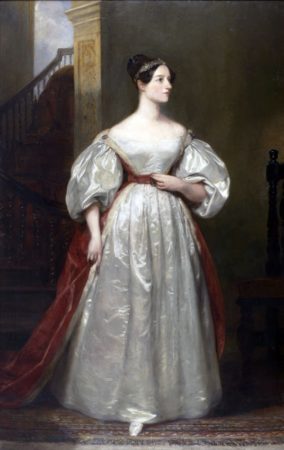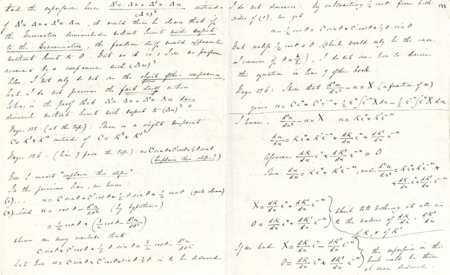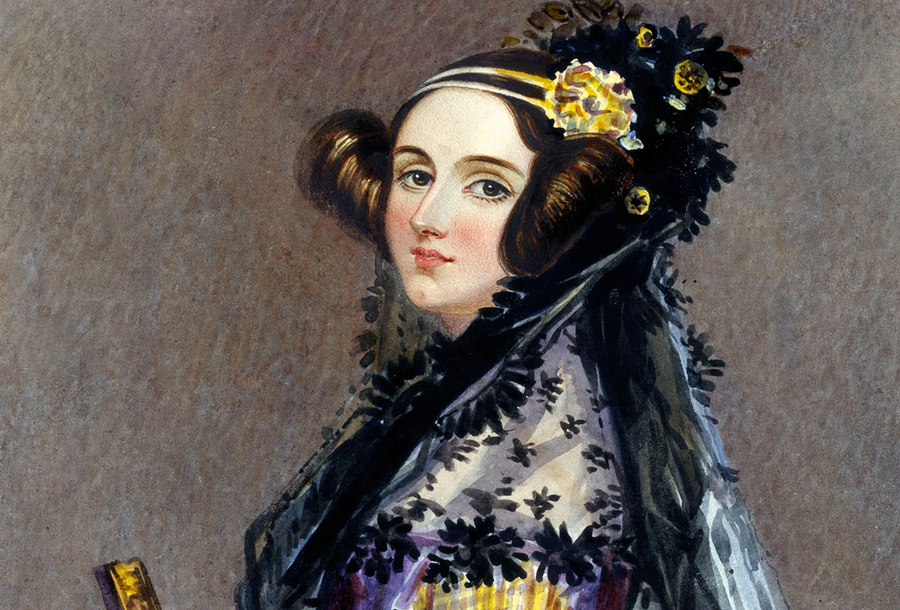Both a pioneer of the Computer Age and the daughter of Lord Byron, the world’s first computer programmer was a complex character
Intelligent, confident and daring, Ada Lovelace was a tech visionary that was ahead of her time. Not only did she write the first computer program, she foresaw a digital future in which machines could do more than basic maths. She is held up as an inspiration for women in science and her life is often romanticised. But behind her ground-breaking achievements was a complex character, who spent her entire life wrestling with both her mental and physical health before her tragic death at the age of just 36.
Augusta Ada Byron was born in London in 1815. Her mother, Lady Annabella Byron, was a clever, upright and deeply religious woman. Meanwhile, her father was the poet Lord Byron, of “mad, bad and dangerous to know” infamy. Ada was named after Augusta Leigh, Byron’s half-sister with whom he was widely suspected of committing incest.
It is perhaps no surprise that, just a few weeks after her birth, Ada’s parents separated. Lady Byron became exasperated with her husband’s maddening behaviour. Finalised in March 1816, the nasty split caused an embarrassment in society, forcing Lord Byron to escape England and pursue a life abroad. He never returned to English soil and he died eight years later in Greece, having never laid eyes on his daughter again.
Lady Byron, a highly educated woman, provided her daughter with the same rigorous training in science and maths that she herself had received as a child. She hoped it would prevent Ada, who was energetic and inclined to mood swings from a young age, from following the same destructive path as her father. It was an unconventional education for a 19th century girl but it marked Ada’s introduction to the scientific world.
Ada enjoyed her education and developed a love for machines. Growing up during the industrial revolution, she loved to study diagrams of the ingenious inventions that were emerging. In 1828, at the age of 12, she started designing her own, drawing up plans for a steam-powered flying machine. It was clear that from a young age Ada was destined to be a forward thinker.

She continued to develop her mathematical skills despite the recurrent bouts of illness that she suffered from as a child, which plagued her for the rest of her life. When she was a teenager, Ada contracted a nasty case of measles that left her partially paralysed and bed bound for almost a year. It took her a couple of years to recover properly and eventually be able to walk again, albeit with crutches.
Her studies may have demanded her attention, but Ada was always bursting with curiosity and it wasn’t long before she started asking questions about her father. After all, the stigma of being Lord Byron’s daughter followed her wherever she went. Lady Byron forbade Ada from ever speaking about him but she didn’t stop Ada from reading his poetry, which she allegedly found rather boring. Lady Byron’s biggest fear was that her daughter had inherited the same dysfunctional personality that had made her ex-husband prone to melancholy, torrid love affairs and racking up debts.
Even with her mother’s best efforts to suppress her Byronic tendencies, Ada had the same disobedient streak as her father. Aged just 17, she embarked on an affair with her tutor and attempted to elope with him, only to be thwarted by his family. Lady Byron managed to cover up the scandal so Ada was luckily left relatively unscathed by her romantic escapades. However, judging by her pursuits in later life, this experience did nothing to extinguish her taste for rebellion.
Due to her wealth and position in society, Ada had opportunities that were denied to the majority of other women. She surrounded herself with some of the foremost scientific thinkers of her day, including the Scottish astronomer and polymath Mary Somerville. Somerville was an ideal role model, and she fostered Ada’s love for mathematics and became her tutor, all the while encouraging her interest in technology.
It was through Somerville that Ada was introduced to mathematician and mechanical engineer Charles Babbage at a party in 1833, the same year in which she had tried to elope. He was the Lucasian Professor of Mathematics at the University of Cambridge and the inventor of the Difference Engine, a mechanical calculator. He demonstrated his partially built machine to Ada and it captivated her mind, sparking a friendship that became a life-long partnership.
After witnessing the Difference Engine in action, a determined Ada wanted to further her education in mathematics. In a letter to her tutor at the time, Dr William King, she stated: “I find that nothing but very close and intense application to subjects of a scientific nature now seem to keep my imagination from running wild.” King allegedly agreed with his pupil that “a course of severe intellectual study” was what she needed – no doubt believing that this would cure Ada of her unruly tendencies.
For the next two years, Ada committed herself to mathematics and corresponded with both Somerville and Babbage. She attended various society parties where she made connections with prominent male figures including the physicist Michael Faraday, scientist and inventor Charles Wheatstone, and even renowned author Charles Dickens. In the meantime, Lady Byron was on a mission to find Ada a husband, hoping that marriage would keep her on the straight and narrow.
Enter William King, 8th Baron King, a friend of Mary Somerville’s son (not to be confused with Ada’s tutor). King was a decade older than Ada but the pair quickly fell in love Their engagement was almost ruined when Lady Byron insisted that Ada tell her fiancé about her previous liaison with her tutor. In most cases, this would have spelled the end of the relationship but thankfully for Ada, William decided that he still wanted to marry her.
In July 1835, Ada married William and she became Lady King. Between 1836 and 1839, the couple had three children together: two sons, Byron and Ralph, and one daughter, Annabella. Always predisposed to illness, Ada particularly suffered from ill health after the birth of her daughter, taking months to recover. In 1838, William was made the earl of Lovelace and Ada, as his wife, became countess of Lovelace, the moniker that she is best remembered by.
More often than not, marriage signalled the end of a woman’s ‘wilder’ pursuits in favour of dedicating herself to household chores and her children. This was not to be the case for Ada, particularly as William, a scientist himself, encouraged his wife to further her education. Ada needed no convincing as she itched to return to mathematics after the birth of her last child.
Through Babbage, Ada contacted Augustus de Morgan, a renowned mathematician and professor at University College London. De Morgan agreed to send Ada the material he used to teach his students so that she could study from it, as Victorian women were not allowed to actually attend university lectures. They corresponded regularly between 1840 and 1841 and with de Morgan guiding her, Ada immersed herself in advanced calculus.
While pursing her own studies, Ada remained interested in Babbage’s work. In 1837, he proposed a more advanced calculating machine, the Analytical Engine, which would become the forerunner to the modern computer. Three years later he travelled to the University of Turin to explain the concept of his machine. This inspired Luigi Menabrea, the Italian mathematician and future prime minister, to write an article discussing the Analytical Engine that Ada was asked to translate into English in 1842.
After showing Babbage her work, he suggested that Ada add her own annotations to Menabrea’s article, as she understood his research better than most people. When Ada’s translation was eventually published in 1843, she included a supplement she humbly titled Notes. However, this was a little more than a postscript – it was three times the length of Menabrea’s original article. Crucially, within those pages Ada included what is widely considered to be the world’s first ever computer programme. She outlined an algorithm for the Analytical Engine, which would allow the machine to perform a complex equation and identify what are known as Bernoulli numbers.
However, to call Ada ‘the first computer programmer’ is a contentious point. The Analytical Engine was not built during her lifetime, so her conceptualised programme was never properly tested. She collaborated with Babbage on her Notes and sent him copies for advice and revisions, so it is believed that Babbage influenced her ideas. Indeed, he had created his own potential computer programmes in 1836 and 1837, which were unpublished.
Babbage’s work existed long before Ada created her algorithm but hers was the most complete and the one that was published. In spite of the controversy, there is no denying Ada’s monumental contribution to the Analytical Engine. She was a visionary who saw beyond the Engine’s mathematical capabilities and its potential in ways that no one else did, believing that it could be programmed to achieve so much more.
This included her belief that the Engine “might compose elaborate and scientific pieces of music of any degree of complexity or extent”. As it turned out, the world was not ready for Ada’s advanced proposals, and it would take over a century for technology to catch up enough to actually put them into practice.

Despite her remarkable work, Ada’s behaviour spiralled in the last decade of her life. She regularly consumed wine and laudanum, an opiate, to deal with the pain from her ever-frequent periods of illness. Prescribed by her doctor, it became clear that Ada was addicted to the concoction. Her mood swings, present since childhood, became gradually more extreme while she also suffered from hallucinations.
With her husband frequently away on business, Ada was left to fill her spare time with an array of illicit lovers. She was outspoken, flirtatious and her indiscreet affairs were scrutinised by society. Coupled with her shocking, unwomanly behaviour, she was compared to her scandalous father. Yet Ada, who spent most of her childhood rigorously controlled by her mother, honestly could not have cared less about the opinions of others.
Babbage once dubbed Ada ‘the Enchantress of Numbers’ for the way she could manipulate them as if by magic. However, the numbers also enchanted her. Ada was a compulsive gambler. She devised mathematical schemes that she thought would give her a statistical advantage. These all failed spectacularly and she squandered her substantial fortune, reportedly losing £3,200 in one go at the Epsom Derby. Ada was forced to quietly pawn the Lovelace family jewels – twice – in order to pay her creditors.
By 1852, it was obvious that Ada was seriously unwell and it’s believed that she suffered from uterine cancer, which unfortunately became terminal. Ada was prescribed cannabis by her doctors to deal with the excruciating pain when opiates stopped working altogether. She continued to correspond with friends and it seems that in August, Charles Dickens paid Ada a visit, reading her a passage from one
of his novels.
By the end of the summer, Lady Byron had moved in to take care of her ailing daughter. In a twisted act, Lady Byron hid Ada’s painkillers so that the torturous agony would force her daughter to repent for her sinful ways. Aware that she was nearing the end, Ada supposedly made a confession to her husband. What she divulged is unknown, but it upset William so much that he abandoned her on her deathbed.
Following months of suffering in unbearable pain and excessive bloodletting by her doctors, Ada finally passed away in November 1852. She was the same age as her father when he died and even though she barely knew him, there was no denying that Ada was her father’s daughter. After a lifetime of separation, she requested to be buried next to him in Nottinghamshire, much to her mother’s horror.
Despite their revolutionary content, Ada’s Notes on the Analytical Engine were not appreciated in her lifetime. For over a century, she was only remembered as a footnote in biographies of Lord Byron. But Ada’s work was republished in 1953 and her contribution to computing was quickly reevaluated. In 1979, a computer language was named in her honour. Today she is an idol for many women working in mathematics, science and engineering around the world – finally receiving the recognition that she long deserved.
